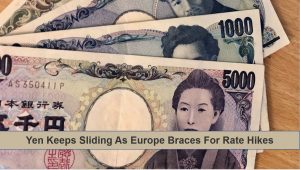Yen Keeps Sliding As Europe Braces For Rate Hikes

The yen hit a fresh 20-year low versus the dollar on Wednesday and slipped to a seven-year trough against the euro as traders awaited a European Central Bank meeting likely to leave Japan alone among its peers in sticking to ultra easy monetary policy.
The ECB meets on Thursday and markets are expecting it to at least lay the groundwork for rapid rate rises, if not begin them with a small hike.
The U.S. Federal Reserve is expected to raise its benchmark funds rate by 50 basis points next week and again in July, but Bank of Japan (BOJ) officials have given no indication of easing accommodative settings.
The yen has accordingly lost more than 4.5% from 127.09 per dollar to touch 133.22 in eight sessions, dropping hard on crosses as investors see soaring consumer prices forcing central banks around the world to crimp demand with rapid rate hikes.
Versus the Australian dollar, the yen has fallen more than 6% in 10 sessions to a seven-year low of 96.12 per Aussie, accelerating the slide after a surprisingly big rate hike in Australia on Tuesday.
It is down 10 sessions in a row on the euro, its longest losing streak in eight months, and found a seven-year low of 142.36 early in Asia trade.
The dollar also firmed on the risk-sensitive Australian and New Zealand dollars, leaving the Aussie down 0.36% at $0.7202 and kiwi down 0.43% at $0.6462,
Important Note: The information found on Ausprime platform is intended only to be informative, is not advice nor a recommendation, nor research, or a record of our trading prices, or an offer of, or solicitation for a transaction in any financial instrument and thus should not be treated as such. The information provided does not include any specific investment objectives, financial situation and needs of any specific person who may receive it. The past performance is not a reliable indicator of future performance and/or results. Past Performance or Forward-looking scenarios are not a guarantee of future performance. Actual results may differ materially from those anticipated in forward-looking or past performance statement
